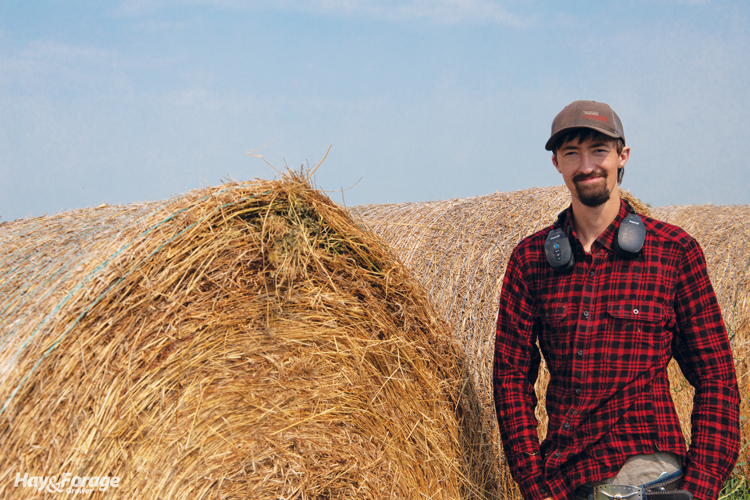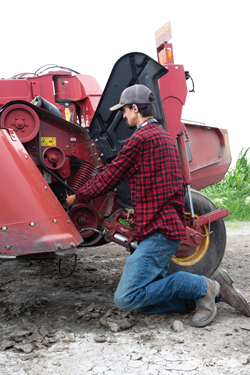Hay north, young man |
| By Mike Rankin, Senior Editor |
|
|
 Tyler Clemetson started his commercial hay business to complement his family's beef operation. Making dry hay is much easier in some regions of the United States than in others. Even so, we can find hay balers methodically rolling in every one of the 49 continental states, even where rain, daylight, and/or a short growing season hinder the most persistent efforts. It’s possible to go farther north in the U.S. than Grand Forks, N.D., but not much farther. As the shivering crow flies, go another 75 miles toward polar bear habitat and you’ll need a passport to enter Manitoba, Canada. Yet it is on the western stretches of Grand Forks where Tyler Clemetson has decided to make his mark in the commercial hay business . . . despite a growing season that mimics a holiday as much as it does a season. Clemetson is a fourth-generation farmer who operates with his father, Ron, and an older brother. Prior to jumping into the commercial hay business, the family’s main enterprise has been beef cattle, even though this part of North Dakota is as void of cows as it is alfalfa fields. To feed their nearly 200 brood cows during the winter, the Clemetsons have historically cut and baled nearly 2,000 acres of grassland owned by the U.S. Fish and Wildlife Service.  Clemetson greases his mower-conditioner to prepare for the next cutting. Wanted to diversify It was the 25-year-old Tyler who decided to start the commercial hay business about four years ago. “We started the hay business to diversify beyond just cows,” he explained. “We already had the equipment, and it’s not that hard to pick up rental ground suitable for alfalfa production because the soils are naturally alkaline around here. Currently, we have a few hundred acres of alfalfa from both owned and rented land, but that acreage continues to grow with demand. Some of the local sugar beet growers are considering alfalfa as a rotation crop because it drastically improves the soil,” he added. With the shorter growing season, Clemetson only gets two or sometimes three cuttings of alfalfa. He’s been establishing his pure alfalfa stands by drilling about 20 pounds of Dairyland seed per acre while using forage barley as a companion crop. First cutting of established stands is typically made about the third week of June just as the alfalfa is starting to flower. As with a lot of Midwest haymakers in 2024, Clemetson said early haymaking and putting in new seedings was made difficult by unrelenting rain. In fact, no new alfalfa fields were established last year. Clemetson’s alfalfa is cut with a New Holland 316 Discbine, windrowed using a Vermeer 12-wheel rake, and baled with a Vermeer 605M round baler. All of the round bales are stacked in rows and left outside. “We’ve never had a problem with mold, or at least I’ve never had a customer call and complain,” Clemetson noted. “We try to have all of our production sold and off the farm before the snow starts flying.” As a relatively young upstart in the hay business, Clemetson said he hasn’t had to rotate out of any previously established fields yet. The young haymaker still isn’t sure how persistent his alfalfa stands will be. “I’m hoping we can get six or seven years out of stands,” Clemetson said. “It gets really cold here, but we also get a lot of snow to help cover the ground. So far, winterkill hasn’t been a problem.” Developing markets Most of Clemetson’s alfalfa goes to beef producers and feedlots throughout the Midwest. “In the last few years, much of our hay went to areas that were impacted by drought,” Clemetson said. He uses both a Facebook page and BisManOnline, a North Dakota-based advertising website, to solicit customers. Clemetson’s plans for the future include growing his commercial hay business in an area where such enterprises are few and far between. “Like a lot of hay growers, our biggest challenge is the weather and the fact that we have to deal with a short growing season every year,” he explained. “Even so, I think there’s enough demand that I can be successful selling hay.” At this point, there’s no reason to doubt the young haymaker. This article appeared in the January 2025 issue of Hay & Forage Grower on page 18. Not a subscriber?Click to get the print magazine. |
